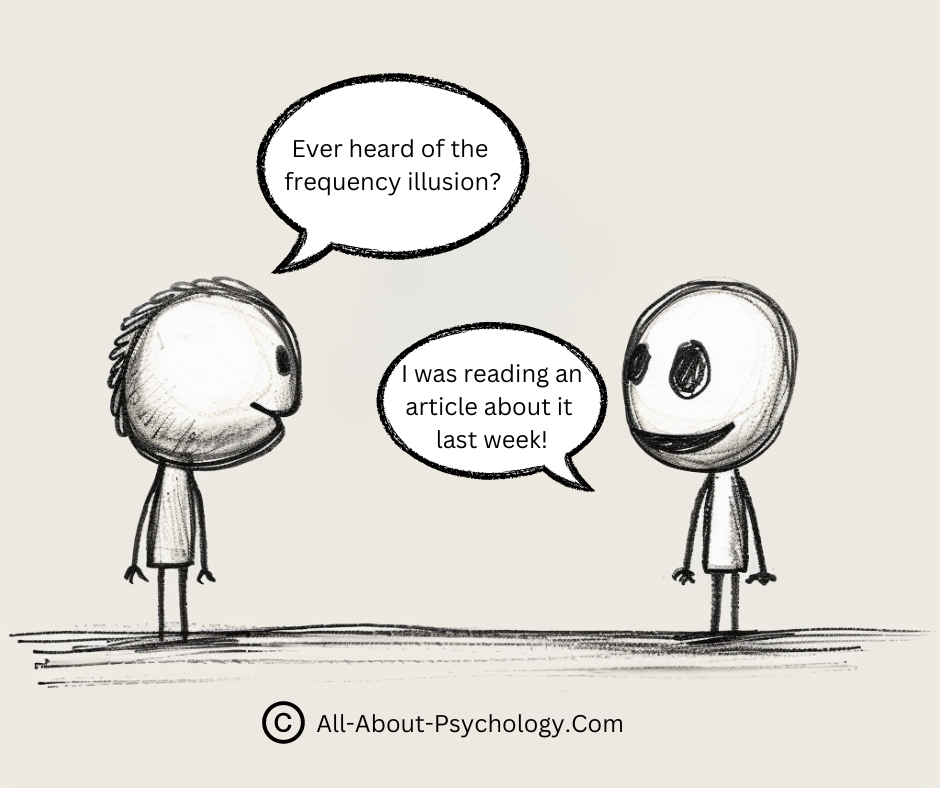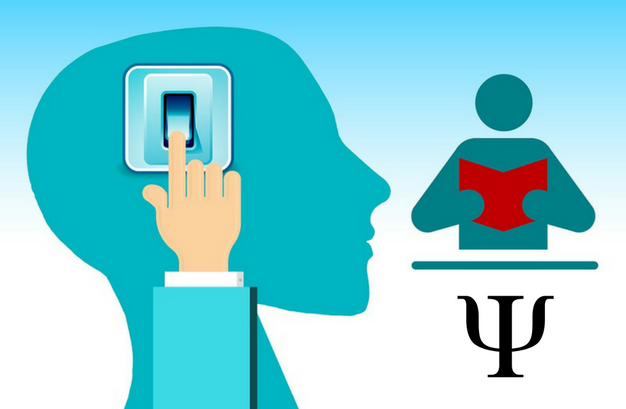Psychology Classics On Amazon

Understanding the Frequency Illusion:
What It Is and Why It Happens
In the realm of cognitive science, various phenomena capture the intricacies of human perception and thought processes. One such intriguing phenomenon is the frequency illusion, a cognitive bias that can significantly influence how we perceive the world around us. Understanding the frequency illusion is essential as it sheds light on the workings of our minds and helps us navigate our daily lives with greater awareness.
What is the Frequency Illusion?
The frequency illusion, also known as the Baader-Meinhof phenomenon, occurs when something that has recently come to our attention suddenly seems to appear with improbable frequency shortly thereafter. This can happen with words, images, concepts, or objects. For example, you learn a new word, and suddenly you notice it everywhere—in conversations, on the radio, in books. It's not that the word has suddenly become more common, but rather your heightened awareness of it makes it appear more frequent.
This illusion is closely related to other cognitive biases such as the confirmation bias, where people tend to search for, interpret, and remember information that confirms their preconceptions. However, the frequency illusion is more about the increased perception of frequency rather than a bias towards confirming one's beliefs.
The Science Behind the Frequency Illusion
The frequency illusion is rooted in the brain's cognitive processes, particularly in how attention and memory function. When we encounter new information that stands out, our brains flag it as important. This heightened attention means we're more likely to notice it again in the future.
Two cognitive processes play a crucial role here: selective attention and confirmation bias. Selective attention occurs when we focus on particular information while ignoring other stimuli. When we become aware of something new, our selective attention zeroes in on it, making us notice it more frequently. Confirmation bias then reinforces this by making us pay more attention to instances that confirm this perceived increase in frequency, while disregarding instances that do not.
Neurologically, this phenomenon involves regions of the brain responsible for attention and memory, such as the prefrontal cortex and the hippocampus. These brain areas work together to flag relevant stimuli and encode them into memory, enhancing their salience and perceived frequency.
Common Triggers of the Frequency Illusion
1. Personal Experiences and New Knowledge: When we learn something new or have a significant personal experience, it becomes more salient in our minds. This heightened salience makes us more likely to notice related occurrences.
2. Media and Advertising Influences: Media and advertising often play a role in triggering the frequency illusion. When exposed to certain products or ideas through advertising, we begin to notice them more frequently in our environment.
3. Social and Environmental Factors: Conversations with friends, trends in social media, and other social influences can also act as triggers. If a friend mentions a new trend or product, it suddenly seems to appear everywhere, reinforcing the frequency illusion.

Psychological Impact of the Frequency Illusion
The frequency illusion can significantly impact our decision-making processes and overall perception of reality.
1. Effects on Decision Making: When something appears more frequent, it can influence our decisions and judgments. For instance, if a particular car model seems to be everywhere after you consider buying it, you might think it's a popular and reliable choice.
2. Influence on Perceptions and Beliefs: The frequency illusion can shape our beliefs and perceptions about the world. If certain ideas or topics seem to appear more frequently, we might assume they are more important or prevalent than they actually are.
3. Potential for Positive and Negative Outcomes: While the frequency illusion can make us more aware of our environment and help us make informed decisions, it can also lead to misconceptions and reinforce biases. Understanding its impact allows us to harness its benefits while mitigating its drawbacks.
Frequency Illusion in Digital and Social Media
The digital age has amplified the frequency illusion, particularly through algorithms and targeted advertising.
1. Algorithms and Targeted Advertising: Social media platforms and search engines use algorithms to personalize content based on our interests and behavior. This can create an echo chamber effect, where we are repeatedly exposed to similar content, reinforcing the frequency illusion.
2. Impact on Consumer Behavior: Targeted advertising exploits the frequency illusion by repeatedly showing us ads for products we've shown interest in. This can lead to increased consumer spending and influence purchasing decisions.
3. Examples from Social Media Platforms: Platforms like Facebook, Instagram, and Twitter use algorithms to keep us engaged by showing content that aligns with our interests. This can make certain topics or products appear more common and relevant, even if they are not.
Real-Life Examples of the Frequency Illusion
To better understand the frequency illusion, let's look at a couple of real-life examples and specific instances:
Example 1: Learning a New Word: Imagine you come across the word "serendipity" for the first time. After learning its meaning, you start noticing it in books, conversations, and even in movies. The word hasn't become more common; your awareness of it has increased.
Example 2: Buying a New Car: After deciding to buy a red Toyota, you begin seeing red Toyotas everywhere. This doesn't mean there are suddenly more red Toyotas on the road; your brain is now primed to notice them due to the frequency illusion.
Debunking Myths and Misconceptions
The frequency illusion is often misunderstood, leading to various myths and misconceptions:
Common Misunderstandings: Some people believe the frequency illusion means something is genuinely becoming more common. In reality, it's our perception that changes, not the actual frequency of occurrence.
Clarifying What the Frequency Illusion is Not: It's important to distinguish the frequency illusion from other cognitive biases and phenomena. It is not about seeking confirmation of beliefs but about heightened awareness of specific stimuli.
Addressing Skepticism and Alternative Explanations: Some may be skeptical of the frequency illusion, attributing increased frequency to external factors. While external factors can play a role, the primary driver is our cognitive processes.
How to Mitigate the Effects of the Frequency Illusion
Understanding the frequency illusion allows us to develop strategies to mitigate its effects, such as:
Improving Critical Thinking and Awareness: By being aware of the frequency illusion, we can critically assess whether an increase in frequency is real or perceived.
Managing Cognitive Biases: Developing habits to question our perceptions and biases can help us make more informed decisions and avoid misconceptions.
Recognizing The Importance of Mindfulness and Reflective Practices: Mindfulness practices can help us become more aware of our thought processes, reducing the impact of cognitive biases like the frequency illusion.
Final Words
The frequency illusion is a fascinating cognitive bias that highlights the intricacies of human perception. By understanding its causes and effects, we can navigate our world with greater awareness and make more informed decisions. Whether it's recognizing the illusion in our daily lives or mitigating its impact through mindfulness and critical thinking, understanding this phenomenon empowers us to better understand ourselves and the world around us.
Want to Read More Great Articles?
See following link to check out a fascinating collection of psychology articles by leading academics and researchers.
This Psychology Symbol - Vintage Retro Striped Sunset T-Shirt is available from Amazon (prime eligible) in a range of colors for women and men. Sales help support this website, which has been providing free and comprehensive information and resources for psychology students and educators since 2008.
Recent Articles
-
Cool People: What Psychology Reveals About Their Global Appeal
Jul 06, 25 12:54 PM
What makes cool people so magnetic? Discover the science behind their traits and why they're admired across cultures - according to global psychology research. -
Sponsor a Psychology Website with Over a Million Yearly Visitors
Jun 30, 25 11:30 AM
Showcase your brand to a huge, engaged audience. Discover how to sponsor a psychology website trusted by over a million visitors a year. -
Unparalleled Psychology Advertising Opportunities
Jun 29, 25 04:23 AM
Promote your book, podcast, course, or brand on one of the web's leading psychology platforms. Discover advertising and sponsorship opportunities today.
Know someone who would love to learn about Understanding the Frequency Illusion: What It Is and Why It Happens? Share this page with them.
Please help support this website by visiting the All About Psychology Amazon Store to check out an awesome collection of psychology books, gifts and T-shirts.
Go From Understanding the Frequency Illusion: What It Is and Why It Happens, Back To The Home Page






